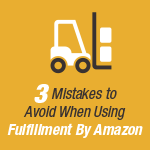 Are you thinking about selling on Amazon? If so, you may want to consider signing on with Fulfillment by Amazon (FBA), which takes product storage, shipping and customer services out of your hands and into Amazon’s purview. By having Amazon manage these tasks, you may find you’re more freed up to focus on other aspects of maintaining and growing your e-commerce business. Here are a few tips to help you get started.
Are you thinking about selling on Amazon? If so, you may want to consider signing on with Fulfillment by Amazon (FBA), which takes product storage, shipping and customer services out of your hands and into Amazon’s purview. By having Amazon manage these tasks, you may find you’re more freed up to focus on other aspects of maintaining and growing your e-commerce business. Here are a few tips to help you get started.
- Scan for your plan. If you’re unsure whether your items are appropriate to sell on Amazon, simply scan the barcode using the Amazon Seller app for iPhone (if you use an Android phone, the Scanpower Gateway app is an alternative). A simple scan will let you know if and how similar products are selling, and makes listing your items a snap.
- Excel in recordkeeping. In your Excel or another spreadsheet system, document each item’s Amazon Stock Information Number, purchase price, net payout amount, and the number of days it took to sell. Meticulous data will help you determine which items you sell are most profitable for you, and whether you need to update listings with improved prices or better descriptions to move products more quickly.
- Weigh your options carefully. While this is always good advice, in this case we’re being literal – a good shipping scale will help you to provide accurate listing information as well as fine-tune your shipping pricing. While a bathroom scale can make do in a pinch for heavier items, your estimates will likely be on the high side and could end up costing you money.
- Preview your printing options. While they’re OK for packing slips and shipping labels, inkjet printers aren’t acceptable for FBA item labels. You can use Amazon’s own label service, which involves an initial setup plus per-label fee, but if you plan to sell a lot and would like to streamline your options, you may wish to invest in a thermal printer.
The Bottom Line
Fulfillment by Amazon takes a lot of legwork out of listing, shipping and managing customer expectations, but it’s important to do the work on your end of the partnership. By setting your FBA business with the right technological tools and investing in equipment to help streamline your operations, you may have the flexibility to devote your business hours to product, marketing, staffing and social media decisions.





